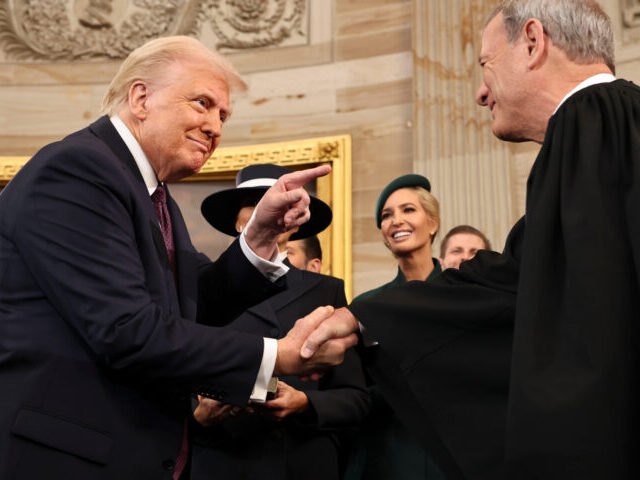Supreme Court Affirms Trump’s Authority Over Executive Agencies, Preserves Fed Independence

The Supreme Court on Thursday allowed President Trump to remove members of two independent federal agencies without cause, reinforcing the principle that the president—not unelected bureaucrats—controls the executive branch.
In an unsigned emergency order, the justices stayed lower court rulings that had blocked Trump’s dismissal of National Labor Relations Board member Gwynne Wilcox and Merit Systems Protection Board member Cathy Harris, both Biden appointees. The decision permits the firings to stand while appeals proceed and strongly suggests the justices are prepared to uphold Trump’s view that officials who exercise executive power serve at the pleasure of the president.
“The Constitution vests the executive power in the President,” the Court wrote, “and he may remove without cause executive officers who exercise that power on his behalf, subject to narrow exceptions recognized by our precedents.” The justices added that the NLRB and MSPB “exercise considerable executive power,” and concluded that the government is likely to prevail on the merits.
Although the ruling does not overturn the Court’s 1935 decision in Humphrey’s Executor v. United States, which upheld removal protections for certain agency heads, the justices explicitly declined to reaffirm that precedent. “That question is better left for resolution after full briefing and argument,” the majority wrote.
The ruling is the latest in a string of decisions affirming presidential control over the administrative state. In Seila Law v. CFPB (2020), the Court struck down statutory limits on the president’s ability to fire the director of the Consumer Financial Protection Bureau. In Collins v. Yellen (2021), it invalidated similar restrictions on the Federal Housing Finance Agency. Thursday’s order extends that reasoning to bipartisan, multi-member agencies that have historically operated outside of direct presidential control.
Justice Elena Kagan dissented, joined by Justices Sonia Sotomayor and Ketanji Brown Jackson. She warned that the majority’s logic could “upend Humphrey’s” and objected to what she characterized as a shift in constitutional doctrine without full briefing. But the Court emphasized that its action was consistent with its recent cases and grounded in Article II’s grant of executive power.
The decision carries immediate practical consequences. With Wilcox and Harris removed, both the NLRB and MSPB lack the quorum necessary to function. The ruling also bolsters Trump’s position in ongoing efforts to restructure the federal bureaucracy. In recent months, the administration has moved to reduce the size of the Department of Education and launched the Department of Justice for the Executive (DOGE) to investigate potential misconduct within regulatory agencies.
Legal challenges to those initiatives have frequently relied on claims of agency independence or attempts to treat executive actions as justiciable under nondelegation or appointment clause theories. But those efforts now face a higher bar. In McMahon v. Department of Education earlier this month, a lower court ruled that Trump’s orders downsizing the Education Department violated statutory norms and exceeded presidential power. Thursday’s ruling raises doubts about whether courts can second-guess such actions when they involve presidential oversight of executive agencies.
The Court drew a careful line around the Federal Reserve, however, responding to concerns that the decision might threaten the central bank’s independence. The respondents, Wilcox and Harris, argued that similar logic could expose Fed governors to arbitrary dismissal. The Court disagreed.
“The Federal Reserve is a uniquely structured, quasi-private entity that follows in the distinct historical tradition of the First and Second Banks of the United States,” the justices wrote, distinguishing it from conventional executive agencies. That carve-out appeared designed to maintain market confidence.
Trump had publicly criticized Fed Chair Jerome Powell in April, writing online that “Powell’s termination cannot come fast enough,” though he later said he had “no intention” of removing him. Fed officials have maintained that the institution’s statutory independence is intact, and according to people familiar with the matter, legal advisers have told the president that courts are unlikely to authorize his removal.
Justice Kagan, in her dissent, argued—without supporting precedent—that the Federal Reserve’s protections rest on the “same constitutional and analytic foundations” as agencies like the NLRB and FTC. But she did not address a key constitutional distinction: monetary policy authority flows from Congress, not the executive, arguably placing the Fed outside the scope of Article II’s removal power.
The Court’s stay remains in effect pending resolution in the D.C. Circuit and any future review by the Supreme Court. If the Court grants certiorari, the stay will remain until a final judgment is issued. If not, it will terminate automatically.
The case is Trump v. Wilcox, No. 24A966.